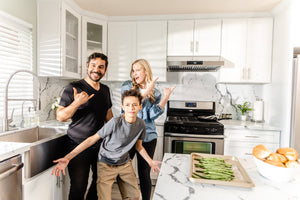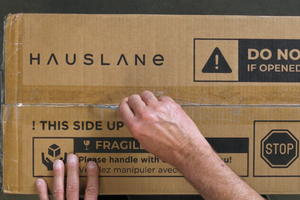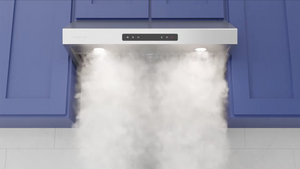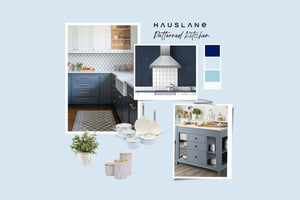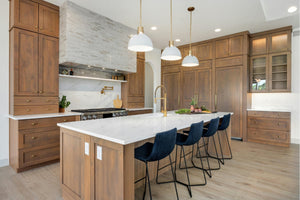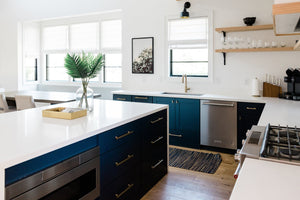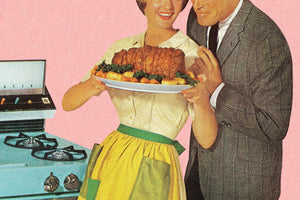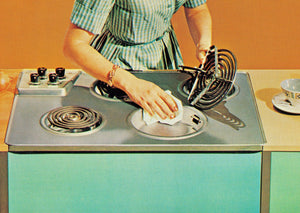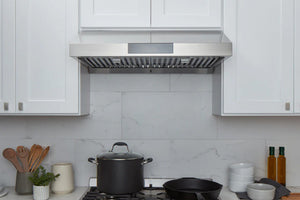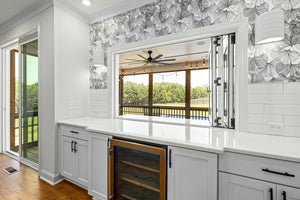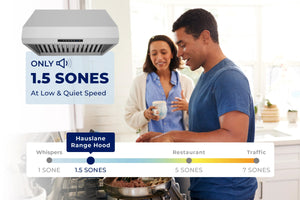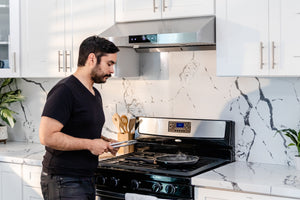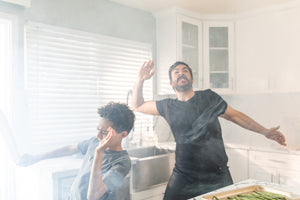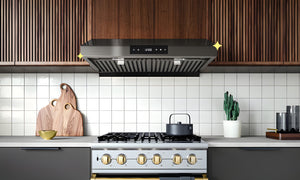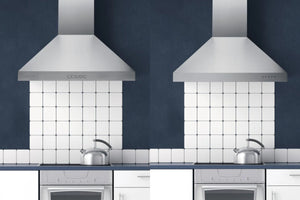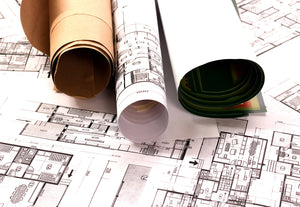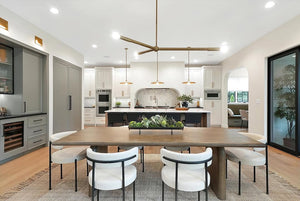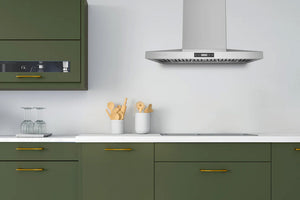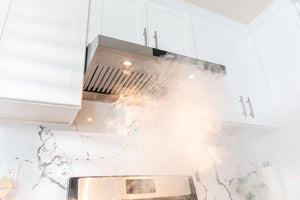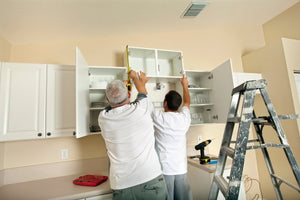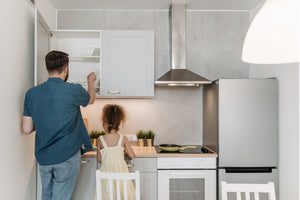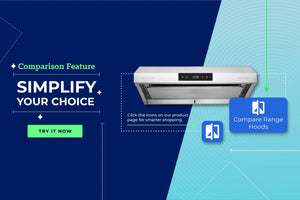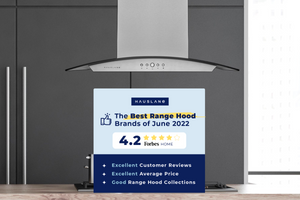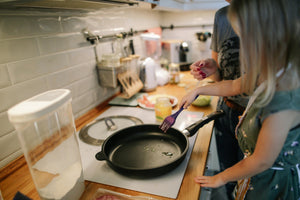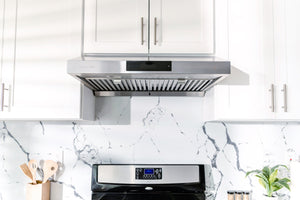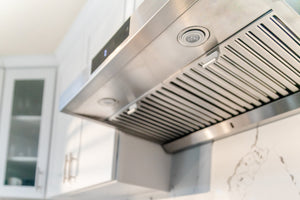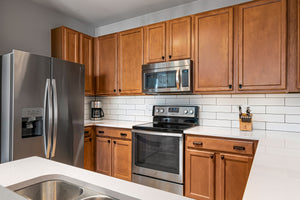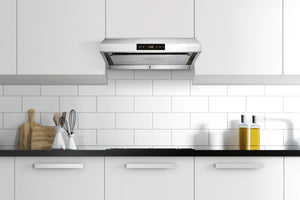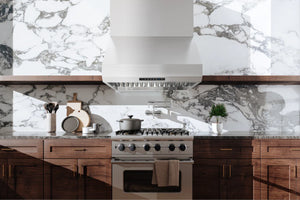TIPS & GUIDES
What Is a Convertible Range Hood?
By Hauslane ∙ 15 mins readThe first question on your mind is likely the following: What does a range hood do? A convertible range hood is an appliance designed to remove smoke, steam, grease, cooking fumes, and odors from the air in your kitchen, with or without ductwork for ventilation. Using a range hood to collect the grease and smoke from the air means you’ll have less of that oily residue on your walls and ceiling, meaning your kitchen – and the air you breathe – is cleaner, even if it is not possible to ventilate your range hood fan to the outside.

There are various range hood styles to choose from. Some of the most popular include:
✦ A wall-mount range hood is installed on the wall directly above the stove.
✦ An under-cabinet range hood fits underneath an over-stove cabinet.
✦ A ceiling-mounted or island range hood attaches to the ceiling so it can be placed over an island stove set away from a wall.
Range hoods can be ducted, ductless, or convertible. Convertible range hoods can be used for either or both setups, meaning they’re flexible, adaptable and ultra-practical.
How Does a Vent Hood Work?
✦ Ventilated

A ventilated range hood uses a fan to pull the steam, smoke, heat, grease and cooking fumes from your kitchen. It then expels them outdoors via a duct or vent. If you require a professional level range hood with a high CFM, you’ll need a ducted or ventilated range hood system. It has a metallic grease filter, usually stainless steel or aluminum mesh. The mesh filter collects grease and smoke particles so they are not released out through the vent. These are very easily cleaned.
Container slightly larger than the filter – no need to buy a specific container, a large baking pan with sides might suffice, or it may fit in your sink.
✦ Non-ventilated

A non-ventilated range hood uses a fan but has no duct to the outdoors. Rather, it uses filters to clean the air and recycle it back into your kitchen. The filter is the most important part of a non-ventilated system, and there are several types available:
✦ Convertible
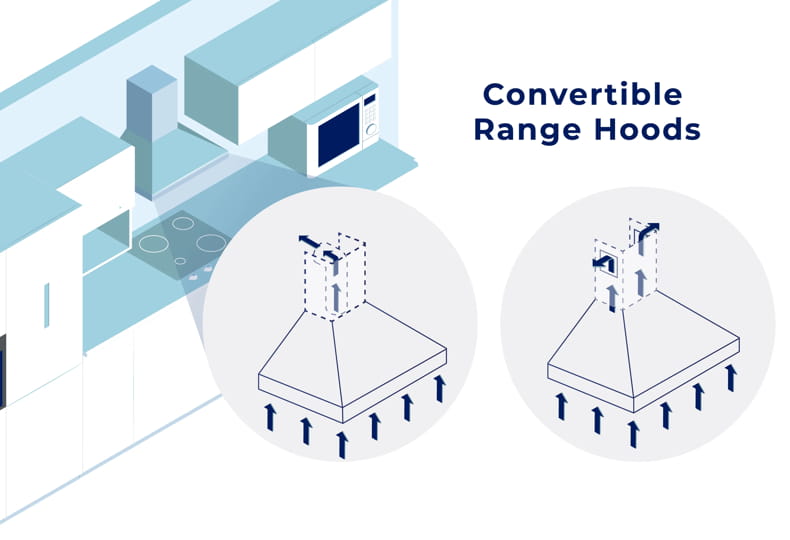
If you’re wondering what a convertible range hood is, this system can use either ducted or ductless venting systems. It has a powerful fan that can be attached to a duct and ventilated on the outside and both a metal mesh and a charcoal filter through which the air is circulated to remove odors and particulates for recirculation. You can install convertible range hoods to either recirculate or vent through ductwork, depending on your kitchen setup.
There are pros and cons to each venting system. Choosing a convertible range hood allows for more flexibility in placement.
What Type of Range Hood Should I Buy?
Now that you understand the different range hood styles and how vent hoods work, you may be asking yourself this: “What type of range should I buy?” Here are some tips to help guide your purchase decision.
Kitchen Layout & Architecture
Your kitchen layout helps determine the kind of range hood you need. Your range may be on an interior or exterior wall, with or without ductwork leading outside. If you have a multi-storied home and your range is on an interior wall, a ducted range hood may not be possible. In a very old home, ductwork renovations may be too big an expense. This is somewhere that a convertible range hood can be very beneficial.
You may have cabinetry or an architectural feature over your cooktop, requiring a low-profile or hidden range hood. Or your range might be located on an island, where your range hood needs to come down from the ceiling.
Before you shop for a range hood, make sure you understand how placement and architectural features influence your decision.
Need help to decide which is the best range hood for you? Check out Hauslane models for range hoods loved by customers all over the world. Our top-of-the-line appliances are available through retailers near you!
Knowing the pros and cons of various range hood styles can also help you choose. Here’s what you need to know about the advantages and disadvantages of the three most common types of range hoods.
PROS
A ventilated range hood removes the unwanted particles from the area altogether. They use a fan and duct to remove the smoke, steam, excess heat, humidity and odors, leaving your cooking area fresh and clean. Ventilated kitchen hoods have powerful and efficient high-speed fans. They tend to be quieter than non-ventilated systems.
CONS
Ventilation ducts can be expensive to install, especially in older homes. They must be positioned in a place where pipes can connect the duct to the exterior of the building, so if you live in a multi-story home and your stove is on an interior wall, a ducted system may be impossible to fit. Ideally ventilated range hoods are placed on exterior walls.
PROS
Non-ventilated range hoods are ductless. This means they can be placed anywhere in your kitchen and don’t require access to the outdoors. They’re generally less expensive and are easier to fit. They require less energy as the exhaust fan doesn’t need to work as hard. Baffle filters can often go in the dishwasher for hassle-free, easy cleaning.
CONS
Less effective than ventilated hood systems. Non-ventilated range hoods recycle the air back into your kitchen, so they don’t remove heat or humidity from the cooking area. Filters need to be cleaned or replaced regularly. If your Ductless range hood is to be used over an island-based stove, you’ll need it to be attached to the ceiling. If the ceiling is very high you might need to purchase an extension to bring it down to an optimum efficiency level. Non-ventilated range hoods are generally louder than ventilated systems.
✦ Convertible Range Hoods (future home improvements/ductwork)
PROS
If you’re wondering, “What is a convertible range hood?” we can help you figure this out. A convertible range hood comes with even more flexibility of placement. If you plan on moving your cooking area about in the future, you can easily change the range hood to suit your new placement, whether that will be ducted or not.
CONS
Can be more expensive to purchase.
If setting up your range hood as a ductless system, you’ll need a filter. Most use charcoal and these need to be replaced regularly.
Conclusion
The range hood you choose should fit your space, architecture, and your aesthetic. After those considerations, look at the features and performance. Hauslane is taking on the mission to provide a brand new cooking experience by making a range hood works for your kitchen. To learn more about what a convertible range hood is, get in touch with Hauslane today.




